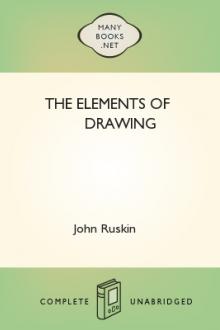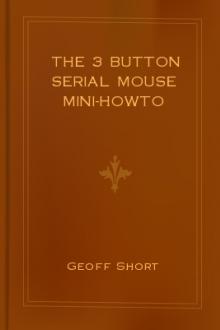The Elements of Drawing by John Ruskin (smart books to read .txt) 📕

xii. One task, however, of some difficulty, the student will find I have not imposed upon him: namely, learning the laws of perspective. It would be worth while to learn them, if he could do so easily; but without a master's help, and in the way perspective is at present explained in treatises, the difficulty is greater than the gain. For perspective is not of the slighte
Read free book «The Elements of Drawing by John Ruskin (smart books to read .txt) 📕» - read online or download for free at americanlibrarybooks.com
- Author: John Ruskin
- Performer: -
Read book online «The Elements of Drawing by John Ruskin (smart books to read .txt) 📕». Author - John Ruskin
91. If you cannot get either a Rembrandt or a Dürer, you may still learn much by carefully studying any of George Cruikshank's etchings, or Leech's wood-cuts in Punch, on the free side; with Alfred Rethel's and Richter's[20] on the severe side. But in so doing you will need to notice the following points:
92. When either the material (as the copper or wood) or the time of an artist does not permit him to make a perfect drawing,—that is to say, one in which no lines shall be prominently visible,—and he is reduced to show the black lines, either drawn by the pen, or on the wood, it is better to make these lines help, as far as may be, the expression of texture and form. You will thus find many textures, as of cloth or grass or flesh, and many subtle effects of light, expressed by Leech with zigzag or crossed or curiously broken lines; and you will see that Alfred Rethel and Richter constantly express the direction and rounding of surfaces by the direction of the lines which shade them. All these various means of expression will be useful to you, as far as you can learn them, provided you remember that they are merely a kind of shorthand; telling certain facts not in quite the right way, but in the only possible way under the conditions: and provided in any after use of such means, you never try to show your own dexterity; but only to get as much record of the object as you can in a given time; and that you continually make efforts to go beyond such shorthand, and draw portions of the objects rightly.
93. And touching this question of direction of lines as indicating that of surface, observe these few points:
Fig. 10. Fig. 10.If lines are to be distinctly shown, it is better that, so far as they can indicate anything by their direction, they should explain rather than oppose the general character of the object. Thus, in the piece of wood-cut from Titian, Fig. 10, the lines are serviceable by expressing, not only the shade of the trunk, but partly also its roundness, and the flow of its grain. And Albert Dürer, whose work was chiefly engraving, sets himself always thus to make his lines as valuable as possible; telling much by them, both of shade and direction of surface: and if you were always to be limited to engraving on copper (and did not want to express effects of mist or darkness, as well as delicate forms), Albert Dürer's way of work would be the best example for you. But, inasmuch as the perfect way of drawing is by shade without lines, and the great painters always conceive their subject as complete, even when they are sketching it most rapidly, you will find that, when they are not limited in means, they do not much trust to direction of line, but will often scratch in the shade of a rounded surface with nearly straight lines, that is to say, with the easiest and quickest lines possible to themselves. When the hand is free, the easiest line for it to draw is one inclining from the left upwards to the right, or vice versâ, from the right downwards to the left; and when done very quickly, the line is hooked a little at the end by the effort at return to the next. Hence, you will always find the pencil, chalk, or pen sketch of a very great master full of these kind of lines; and even if he draws carefully, you will find him using simple straight lines from left to right, when an inferior master would have used curved ones. Fig. 11 is a fair facsimile of part of a sketch of Raphael's, which exhibits these characters very distinctly. Even the careful drawings of Leonardo da Vinci are shaded most commonly with straight lines; and you may always assume it as a point increasing the probability of a drawing being by a great master if you find rounded surfaces, such as those of cheeks or lips, shaded with straight lines.
Fig. 11. Fig. 11.94. But you will also now understand how easy it must be for dishonest dealers to forge or imitate scrawled sketches like Fig. 11, and pass them for the work of great masters; and how the power of determining the genuineness of a drawing depends entirely on your knowing the facts of the objects drawn, and perceiving whether the hasty handling is all conducive to the expression of those truths. In a great man's work, at its fastest, no line is thrown away, and it is not by the rapidity, but the economy of the execution that you know him to be great. Now to judge of this economy, you must know exactly what he meant to do, otherwise you cannot of course discern how far he has done it; that is, you must know the beauty and nature of the thing he was drawing. All judgment of art thus finally founds itself on knowledge of Nature.
95. But farther observe, that this scrawled, or economic, or impetuous execution is never affectedly impetuous. If a great man is not in a hurry, he never pretends to be; if he has no eagerness in his heart, he puts none into his hand; if he thinks his effect would be better got with two lines, he never, to show his dexterity, tries to do it with one. Be assured, therefore (and this is a matter of great importance), that you will never produce a great drawing by imitating the execution of a great master. Acquire his knowledge and share his feelings, and the easy execution will fall from your hand as it did from his: but if you merely scrawl because he scrawled, or blot because he blotted, you will not only never advance in power, but every able draughtsman, and every judge whose opinion is worth having, will know you for a cheat, and despise you accordingly.
96. Again, observe respecting the use of outline:
All merely outlined drawings are bad, for the simple reason, that an artist of any power can always do more, and tell more, by quitting his outlines occasionally, and scratching in a few lines for shade, than he can by restricting himself to outline only. Hence the fact of his so restricting himself, whatever may be the occasion, shows him to be a bad draughtsman, and not to know how to apply his power economically. This hard law, however, bears only on drawings meant to remain in the state in which you see them; not on those which were meant to be proceeded with, or for some mechanical use. It is sometimes necessary to draw pure outlines, as an incipient arrangement of a composition, to be filled up afterwards with color, or to be pricked through and used as patterns or tracings; but if, with no such ultimate object, making the drawing wholly for its own sake, and meaning it to remain in the state he leaves it, an artist restricts himself to outline, he is a bad draughtsman, and his work is bad. There is no exception to this law. A good artist habitually sees masses, not edges, and can in every case make his drawing more expressive (with any given quantity of work) by rapid shade than by contours; so that all good work whatever is more or less touched with shade, and more or less interrupted as outline.
Fig. 12. Fig. 12.97. Hence, the published works of Retzsch, and all the English imitations of them, and all outline engravings from pictures, are bad work, and only serve to corrupt the public taste. And of such outlines, the worst are those which are darkened in some part of their course by way of expressing the dark side, as Flaxman's from Dante, and such others; because an outline can only be true so long as it accurately represents the form of the given object with one of its edges. Thus, the outline a and the outline b, Fig. 12, are both true outlines of a ball; because, however thick the line may be, whether we take the interior or exterior edge of it, that edge of it always draws a true circle. But c is a false outline of a ball, because either the inner or outer edge of the black line must be an untrue circle, else the line could not be thicker in one place than another. Hence all "force," as it is called, is gained by falsification of the contours; so that no artist whose eye is true and fine could endure to look at it. It does indeed often happen that a painter, sketching rapidly, and trying again and again for some line which he cannot quite strike, blackens or loads the first line by setting others beside and across it; and then a careless observer supposes it has been thickened on purpose: or, sometimes also, at a place where shade is afterwards to inclose the form, the painter will strike a broad dash of this shade beside his outline at once, looking as if he meant to thicken the outline; whereas this broad line is only the first installment of the future shadow, and the outline is really drawn with its inner edge.[21] And thus, far from good draughtsmen darkening the lines which turn away from the light, the tendency with them is rather to darken them towards the light, for it is there in general that shade will ultimately inclose them. The best example of this treatment that I know is Raphael's sketch, in the Louvre, of the head of the angel pursuing Heliodorus, the one that shows part of the left eye; where the dark strong lines which terminate the nose and forehead towards the light are opposed to tender and light ones behind the ear, and in other places towards the shade. You will see in Fig. 11 the same principle variously exemplified; the principal dark lines, in the head and drapery of the arms, being on the side turned to the light.
Fig. 13. Fig. 13.98. All these refinements and ultimate principles, however, do not affect your drawing for the present. You must try to make your outlines as equal as possible; and employ pure outline only for the two following purposes: either (1.) to steady your hand, as in Exercise II., for if you cannot draw the line itself, you will never be able to terminate your shadow in the precise shape required, when the line is absent; or (2.) to give you shorthand memoranda





Comments (0)